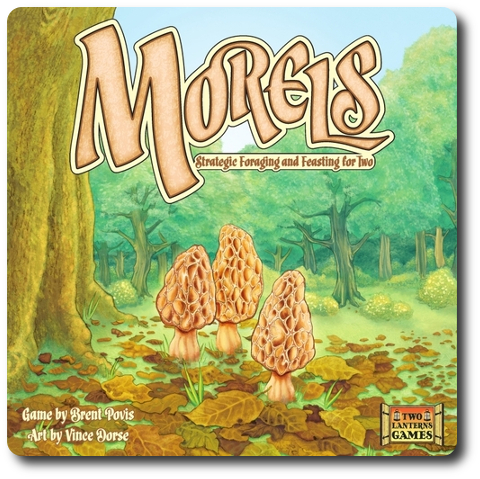
The Basics:
- For ages 10 and up
- For 2 players
- Approximately 30 minutes to complete
Geek Skills:
- Counting & Math
- Logical & Critical Decision Making
- Strategy & Tactics
- Hand/Resource Management
Learning Curve:
- Child – Easy
- Adult – Easy
Theme & Narrative:
- Search the forest for the perfect mushroom
Endorsements:
- Gamer Geek approved!
- Parent Geek approved!
- Child Geek approved!
Overview
Professor John Tyler Booner said, “The sudden appearance of mushrooms after a summer rain is one of the more impressive spectacles of the plant world.” Mushrooms look otherworldly and tend to grow in secret places. They can be used for food and have unique pharmaceutical properties. But they can also be deadly. In this game, you best know the difference between what tastes great and what will put you in the ground.
Morels, designed by Brent Povis and published by Two Lanterns Games, is comprise of 84 Day cards, 8 Night cards, 2 Guide cards, 16 Foraging Stick tokens, and 2 Pan token. The cards are as thick and as durable as your standard playing card. The tokens are made of thick cardboard.
Game Set Up
To set up the game, first have both players site opposite of each other. Ensure that there is enough space to the left, right and in front of every player for cards. The space directly in front of the player is referred to as their “play area”. Place 1 Pan token in each play area.
Second, separate the Night cards from the Day cards to create the Night and Day decks. Shuffle each deck separately and place them face-down to one side of the game playing area.
Third, draw 8 cards from the Day draw deck and place them in a row, face-up, in-between the players. This row of cards is referred to as the “forest”. Then deal each player 3 cards from the Day deck. These cards are the player’s starting hand. Players should keep their hand hidden at all times.
That’s it for game set up. Place the Foraging Stick tokens in a pile to on side of the game playing area. Time to hunt down some tasty morsels.
Mycology 101
Mycology is a specialized branch of biology that focuses on the study of fungi. As a player, you need not be an expert or even like the taste of mushrooms to play the game. You do, however, need to know a bit more than the average Joe to properly explore the forest and find tasty mushrooms.
Mushrooms
All mushrooms can be broken down by type, taste, rarity, and market price. Each mushroom card will have a specific name indicating the type. The Pan and Foraging Stick icons with a number value represents the mushroom’s overall taste, rarity, and market price.
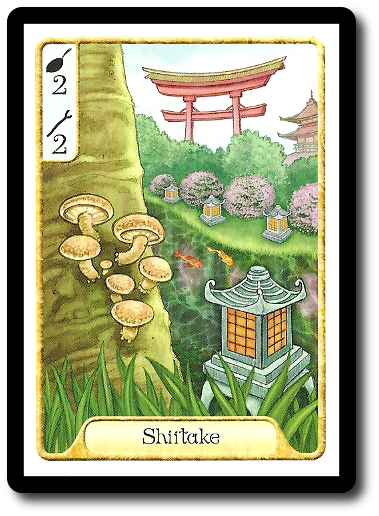
Pans, Baskets, and Foraging Sticks
Each player starts with a Pan token and will later in the game find and be able to play Pan cards. Pans are used to cook the mushrooms which will result in points.
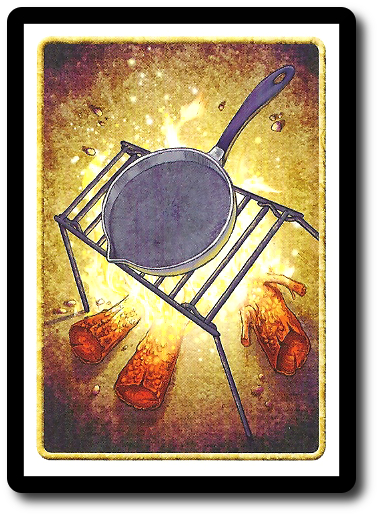
Baskets are used to help carry mushrooms. The player’s card hand size is initially limited. With the use of Baskets, the player can hold more cards, resulting in more mushrooms to claim as their own.
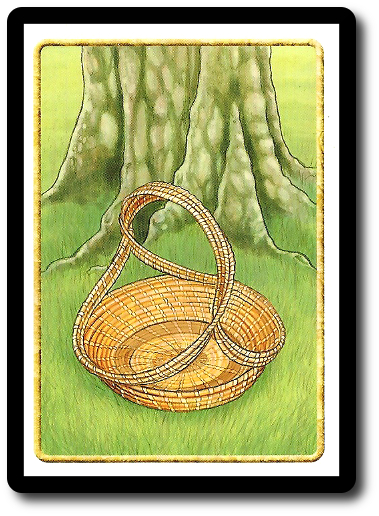
Foraging Sticks are used as a type of currency, where a player “pays” the cost of foraging deep in the forest by spending the Foraging Stick tokens.
The Moon
The Moon card allows the player to collect special types of mushrooms that are only available at night. Mushrooms found at night are worth more than a single mushroom (which is the norm for those found in the Day draw deck), but only take 1 card space in the player’s hand. While mushrooms found by the light of the Moon are much more economical, they are also much harder to come by. Which makes total sense when you consider, thematically, that the player is rooting around in the dirt in the dark.
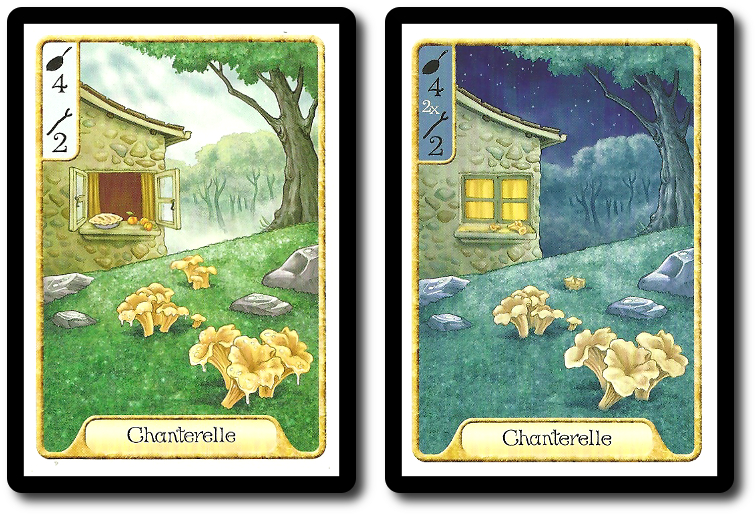
Destroying Angels
The Destroying Angel is a special type of mushroom that is downright nasty in the game and deadly in real life. If the player should ever claim a Destroying Angel as their own, it’s immediately resolved. The player must discard their hand size down to 4 cards, plus an additional 2 for each Basket card they have in play. In addition, the Destroying Angle temporarily limits the player’s hand size limit. For example, a player with 1 Basket in play would have to discard down to 6 cards and now has a hand size limit of 6. which doesn’t sound that bad, but there’s a catch. The Deadly Angel continues to limit the player’s hand, 1 additional round per Pan token and Pan card in play that has been used to cook. This means if the player has 1 Pan token and 2 Pan cards in play with cooked mushrooms, they must always discard down to their new hand size limit for their current turn and has a temporary limited hand size for 3 additional turns. A player can never, ever take cards into their hand that would result in more cards than their current hand size limit allows.
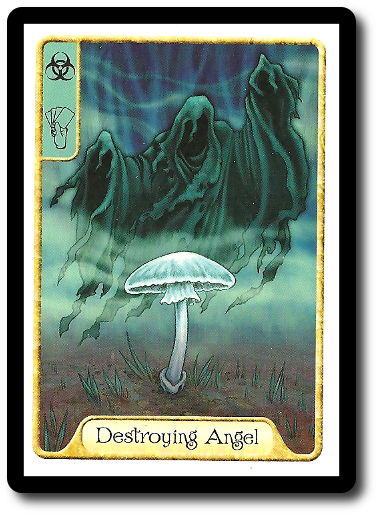
A player may never have more than one Destroying Angel in play at a time that is causing them a great deal of trouble. A double dose of the nasty thing would certainly kill them (which in real life is absolutely true). After the required number of turns have been passed that are effected by the Destroying Angel, it’s discarded and the player’s hand size limit returns to its current natural state. If the player really wanted to, they could immediately poison themselves again. Newly cooked mushrooms during the turns that are penalized do not increase the length of time the penalty is in place.
A Walk in the Woods
Morels is played in turns. On a player’s turn they must take one of five possible actions. The actions are summarized here.
Action Option 1: Take a Card
This action allows the player to take 1 card from the forest, but only if taking the card does not exceed the player’s hand size limit (8 cards by default, but the limit increases as the game progresses).
Where the card is located in the forest will determine its cost. The first two cards closest to the Decay pile (a pile of cards on the far side of the forest row of cards) are considered at the player’s “feet” and will not cost the player nothing to collect. Any other card in the forest row is considered “in the woods”. The deeper the player goes into the woods, the more Foraging Sticks they will have to pay. It costs 1 Foraging Stick per card for every card space away from the two cards at the player’s feet.
For example, the following image represents a typical game set up area. Note that the two cards next to the Decay pile are considered at the player’s feet and can be taken without spending any Foraging Sticks. If the player wants any other card, they will have to pay for it. The cost in Foraging Sticks is noted as number on each card space, with the cheapest (beyond free) being 1 Foraging Stick and the most expensive being 6 Foraging Sticks (the card closest to the Day and Night draw decks).
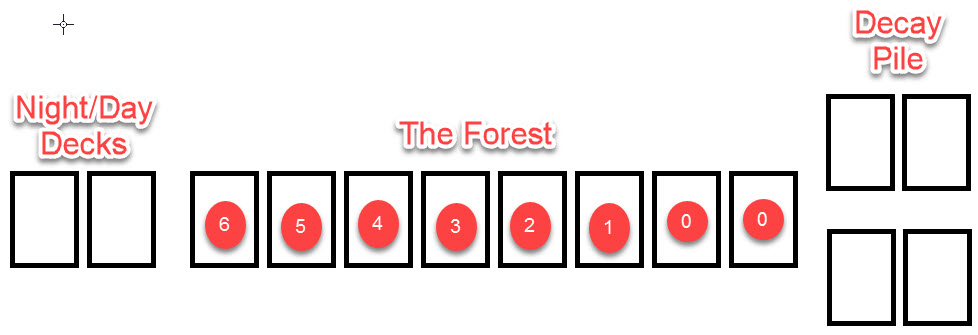
If the collected card is a “Basket” or a “Destroying Angel”, it immediately goes into the player’s play area and does not count towards the player’s current hand size limit. A “Moon” card is immediately discarded into the player’s personal discard pile and allows the player to draw 1 Night card, adding it to their hand (hand size limit applies).
Action Option 2: Take the Decay Cards
This action allows the player to take all the cards currently in the Decay pile and add them to their hand, but only if doing so would not exceed the player’s hand size limit. Again, Baskets, Moons, and Destroying Angels are immediately resolved.
Action Option 3: Cook Mushrooms
This action allows the player to “cook” 3 ore more mushroom cards that display the same mushroom type if they have a Pan token or Pan card free and available. Only one type of mushroom can be cooked per turn. Cooking mushrooms awards the player Mushroom Varietal Points (MVPs). The MVPs to be earned per card in the cooked set are listed on the card next to the Pan icon. For example, 3 mushrooms cooked worth 3 MVPs each would result in 9 MVPs.
A player may either place their 3 matching mushroom cards on a Pan already in their play area or play the 3 matching mushroom cards along with a Pan card.
“Butter” may be added to a set of 4 matching mushroom cards and “Cider” may be added to a set of 5 or more matching mushroom cards. This will result in more MVPs. It’s possible to add both Butter and Cider to the cooking and even two Butters or two Ciders, but the player would have to have a large number of mushrooms, since each Butter and Cider card is assigned to a specific number of cards in the set and no mushroom card can have more than 1 Butte or 1 Cider assigned to it. So, again, very possible, but that’s a lot of cards a player has to collect! I say you go for it…
Cooking mushrooms in a Pan locks the pan and no additional mushrooms can be added to it for the duration of the game.
Action Option 4: Sell Mushrooms
This action allows the player to sell 2 or more mushrooms of the same type. The sold mushrooms are placed in the player’s discard pile. The number of Foraging Sticks to be earned per discarded mushroom in the set is listed on the card next to the Foraging Stick icon. For example, 3 mushrooms discarded worth 3 Foraging Sticks each would result in 9 Foraging Sticks. Player take their Foraging Stick tokens from the Foraging Stick supply pile. There are an infinite number of Foraging Sticks in the game. If, for some crazy reason, there are no more Foraging Sticks to claim, use some other marker temporarily to indicate the player has Foraging Sticks to spend.
Action Option 5: Play an Empty Pan
This action allows the player to play a Pan card to their play area. It can be used in subsequent rounds to cook mushrooms.
Returning Home
At the end of the player’s turn, the forest is set up for the next player by taking the following steps:
1. Remove the closest card in the Forest row to the Decay pile to the Decay pile (mushrooms rot in this game). The Decay pile may never have more than 4 cards. If adding a new card would increase the total number of cards to 5, the player must discard the 4 cards in the Decay pile first. This ensures that each player will always have 1 to 4 cards in the Decay pile on their turn.
2. Slide all the cards in the forest one space towards the Decay pile, filling in the gaps. Draw the necessary number of Day cards to refill the Forest to a total of 8 cards. This step will be skipped towards the end of the game, as the Day deck will be depleted.
It’s now the next player’s turn.
Ending the Game
The game ends as soon as there are no longer any cards left in the Forest. The Forest row will slowly dwindle when the Day draw deck is depleted, resulting in new cards not being added to the Forest.
All players now count their MVPs earned from their cooked mushrooms. Night cards double the MVPs value, while Butter and Cider cards add additional bonus MVPs. Any cards left in the player’s hand do not count for points, but nor do they penalize the player.
The player with the highest MVP wins the game and can claim themselves true fungus aficionado.
Game Variant
If the Destroying Angel is destroying your fun, an alternative rule can be used. Instead of influencing the hand size limit for 1 turn for every used Pan token or Pan card in play, the hand size limit only lasts 1 additional turn. This means the player would immediately discard down to the appropriate number of cards and then must follow the new hand size limit on their next turn only.
To learn more about Morels, visit the game’s web page.
Final Word
 The Child Geeks had no problems learning and playing the game. They quickly demonstrated all the skills necessary to win the day and often sprinkled their game play with various commentary about how much they hated mushrooms in real life. According to one Child Geek, “I really like this game, but I also really hate mushrooms.” Another Child Geek said, “I like that you always have a choice in the game and that makes it feel like I can always work to win the game.” Choices, yes, but which one? That’s the real trick to Morels and the Child Geeks certainly seemed to have plans within plans. Whether playing with their peers or a parent, they held their own and cooked up many mushrooms to satisfy their victory hunger. When the games were over, the Child Geeks voted to approve Morels.
The Child Geeks had no problems learning and playing the game. They quickly demonstrated all the skills necessary to win the day and often sprinkled their game play with various commentary about how much they hated mushrooms in real life. According to one Child Geek, “I really like this game, but I also really hate mushrooms.” Another Child Geek said, “I like that you always have a choice in the game and that makes it feel like I can always work to win the game.” Choices, yes, but which one? That’s the real trick to Morels and the Child Geeks certainly seemed to have plans within plans. Whether playing with their peers or a parent, they held their own and cooked up many mushrooms to satisfy their victory hunger. When the games were over, the Child Geeks voted to approve Morels.
 The Parent Geeks were also fond of the game, finding it to be very engaging and fun. According to one Parent Geek, “The game is really easy to learn, but not easy to win. If you are playing against another opponent who is just as skilled or more skilled than you, this game can get really intense.” This Parent Geek brings up a good point. While a player can stumble their way to victory through smart card plays, a skilled player who joins the game with a strategy and tactics will make quick work of any opponent who doesn’t. This was found to be the case both with Parent Geeks playing with their children and their peers. The good news is, according to one Parent Geek, “If you don’t understand the game, you certainly will after playing just a few hands.” After all the mushrooms were picked, the Parent Geeks voted to approve Morels.
The Parent Geeks were also fond of the game, finding it to be very engaging and fun. According to one Parent Geek, “The game is really easy to learn, but not easy to win. If you are playing against another opponent who is just as skilled or more skilled than you, this game can get really intense.” This Parent Geek brings up a good point. While a player can stumble their way to victory through smart card plays, a skilled player who joins the game with a strategy and tactics will make quick work of any opponent who doesn’t. This was found to be the case both with Parent Geeks playing with their children and their peers. The good news is, according to one Parent Geek, “If you don’t understand the game, you certainly will after playing just a few hands.” After all the mushrooms were picked, the Parent Geeks voted to approve Morels.
 The Gamer Geeks liked the game, finding it to have just the right amount of depth that the game play suggested. They also liked that the choices, while abundant, were limited. According to one Gamer Geek, “I really like those games where they allow the player to take lots of different actions towards winning the game, but the number of actions they can take is limited per turn. It makes you really think and map out how best to win, but it also gives the player a lot of room to maneuver and react to their opponent.” Another Gamer Geek said, “This is a tight game. Simple in its execution and very entertaining, as well as surprisingly difficult if you are playing against a like-minded opponent.” When the games were over, the Gamer Geeks gave Morels their full endorsement.
The Gamer Geeks liked the game, finding it to have just the right amount of depth that the game play suggested. They also liked that the choices, while abundant, were limited. According to one Gamer Geek, “I really like those games where they allow the player to take lots of different actions towards winning the game, but the number of actions they can take is limited per turn. It makes you really think and map out how best to win, but it also gives the player a lot of room to maneuver and react to their opponent.” Another Gamer Geek said, “This is a tight game. Simple in its execution and very entertaining, as well as surprisingly difficult if you are playing against a like-minded opponent.” When the games were over, the Gamer Geeks gave Morels their full endorsement.
 Morels is just plain fun. The game is easy to teach, easy to set up, and easy to get into. The complexity of the game lies just below the surface and is quickly visible to a new and experienced player. With the constant changing of mushrooms, the rush to collect sets, and the need to manage resources, the game challenges players to always consider their best possible action in the moment. A player can (and should) devise a plan, but the necessary tactics and strategy to play the game are more focused on “what’s best right now” rather “what’s best in a couple of turns.” This is because timing is not a great issue in Morels. Focus is.
Morels is just plain fun. The game is easy to teach, easy to set up, and easy to get into. The complexity of the game lies just below the surface and is quickly visible to a new and experienced player. With the constant changing of mushrooms, the rush to collect sets, and the need to manage resources, the game challenges players to always consider their best possible action in the moment. A player can (and should) devise a plan, but the necessary tactics and strategy to play the game are more focused on “what’s best right now” rather “what’s best in a couple of turns.” This is because timing is not a great issue in Morels. Focus is.
I really enjoyed Morels and consider it one of my “go-to” 2-player games. I have played it with kids and adults and found that in all cases the game was balanced. Even a really skilled player can only take one action at a time, reducing their ability to claim a runaway victory. This leaves room for both players to explore a bit, take chances without fear of serious repercussions, and devise new ways to claim their prize. The winner of Morels is the player who takes advantage of their circumstances and never once diverts their attention from the game’s main goal of cooking mushrooms like they were going out of style. The game has just enough “gotchas” to keep things interesting, but never dangerous. Sometimes a player will have to take a hit, but they know full well the benefits they will be claiming as a result. Do play Morels when time permits. It’s a great example of how simple game play can be made into in-depth fun.
This game was given to Father Geek as a review copy. Father Geek was not paid, bribed, wined, dined, or threatened in vain hopes of influencing this review. Such is the statuesque and legendary integrity of Father Geek.



